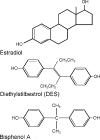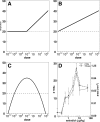Bisphenol-A and the great divide: a review of controversies in the field of endocrine disruption
- PMID: 19074586
- PMCID: PMC2647705
- DOI: 10.1210/er.2008-0021
Bisphenol-A and the great divide: a review of controversies in the field of endocrine disruption
Abstract
In 1991, a group of 21 scientists gathered at the Wingspread Conference Center to discuss evidence of developmental alterations observed in wildlife populations after chemical exposures. There, the term "endocrine disruptor" was agreed upon to describe a class of chemicals including those that act as agonists and antagonists of the estrogen receptors (ERs), androgen receptor, thyroid hormone receptor, and others. This definition has since evolved, and the field has grown to encompass hundreds of chemicals. Despite significant advances in the study of endocrine disruptors, several controversies have sprung up and continue, including the debate over the existence of nonmonotonic dose response curves, the mechanisms of low-dose effects, and the importance of considering critical periods of exposure in experimental design. One chemical found ubiquitously in our environment, bisphenol-A (BPA), has received a tremendous amount of attention from research scientists, government panels, and the popular press. In this review, we have covered the above-mentioned controversies plus six additional issues that have divided scientists in the field of BPA research, namely: 1) mechanisms of BPA action; 2) levels of human exposure; 3) routes of human exposure; 4) pharmacokinetic models of BPA metabolism; 5) effects of BPA on exposed animals; and 6) links between BPA and cancer. Understanding these topics is essential for educating the public and medical professionals about potential risks associated with developmental exposure to BPA and other endocrine disruptors, the design of rigorously researched programs using both epidemiological and animal studies, and ultimately the development of a sound public health policy.
Figures




References
-
- Carson R 1987 Silent spring: 25th anniversary edition. New York: Houghton Mifflin Co.
-
- 1994 Toxic Substances Control Act: EPA’s limited progress in regulating toxic chemicals. http://archive.gao.gov/t2pbat3/151661.pdf
-
- Colborn T, Dumanoski D, Myers JP 1995 Our stolen future. New York: Penguin Books
-
- 1998 Fooling with nature. Interview with Theo Colborn, Ph.D. Frontline, Public Broadcasting Service. http://www.pbs.org/wgbh/pages/frontline/shows/nature/interviews/colborn....
-
- 1992 Wingspread Consensus Statement. In: Colborn T, Clement C, eds. Chemically induced alterations in sexual and functional development: the human/wildlife connection. Princeton, NJ: Princeton Scientific Publishing; 1–8
Publication types
MeSH terms
Substances
Grants and funding
LinkOut - more resources
Full Text Sources
Other Literature Sources

